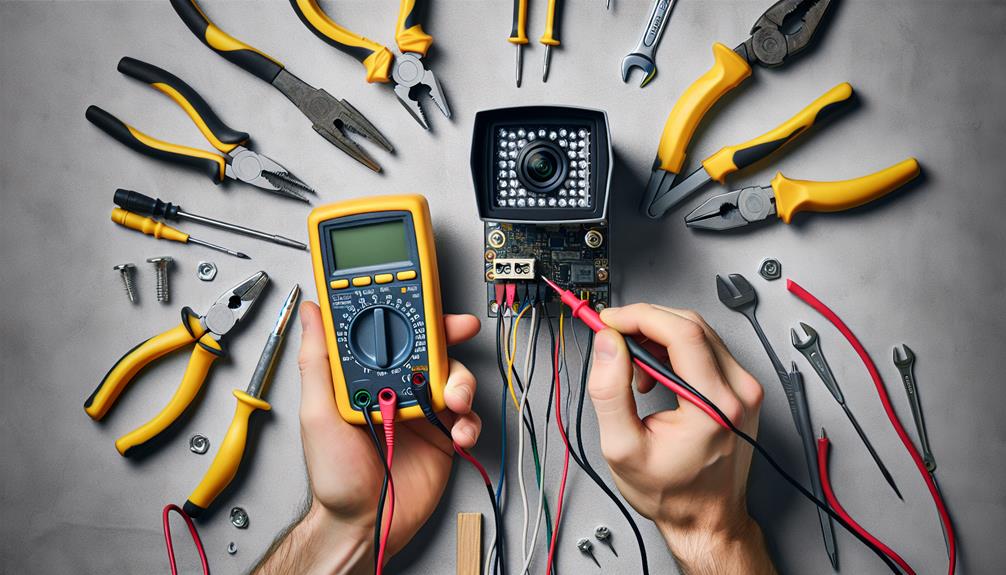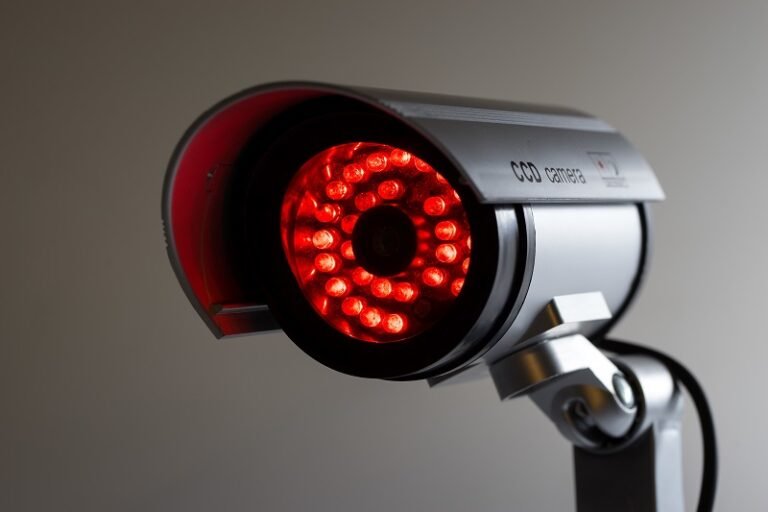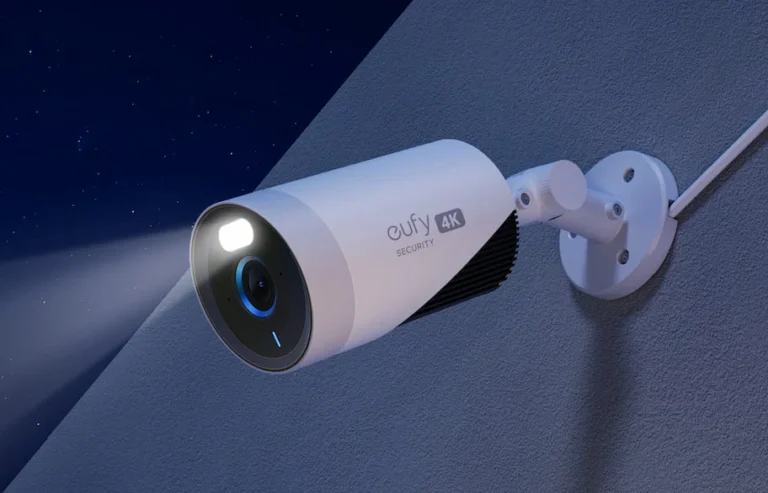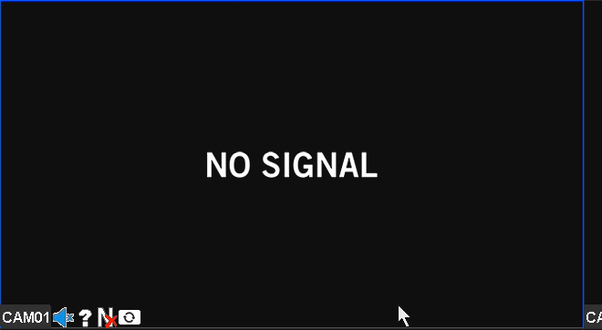To check a CCTV camera with a multimeter, first gather necessary tools like screwdrivers and a flashlight. Turn off the power source to guarantee safety. Set your multimeter to DC voltage, then connect the probes to the camera’s power input terminals. Confirm the voltage matches what’s required for your camera. For continuity, switch to the resistance setting and check the camera’s cable and ground connections. Proper readings will help you pinpoint issues and verify your camera operates correctly. There’s more to understand about guaranteeing your CCTV system works flawlessly if you want to go further.
Gather Necessary Tools
To get started, make sure you have a multimeter, a set of screwdrivers, and a flashlight on hand. These tools are essential for checking your CCTV cameras effectively. You’re probably keen on getting things done yourself, and having these tools ready will give you the freedom to troubleshoot without waiting on someone else.
First, a multimeter is vital. It measures electrical properties like voltage, current, and resistance, which are key to diagnosing any issues with your camera system. If you don’t already own one, investing in a reliable multimeter will pay off in the long run, offering you the autonomy to handle various electrical tasks.
Next, a set of screwdrivers is indispensable. CCTV cameras often have screws that need to be removed or adjusted. Having both flathead and Phillips screwdrivers ensures you can tackle any type of screw you encounter.
Lastly, a flashlight will help you see clearly in tight or dimly lit spaces. Good visibility is essential when you’re dealing with intricate wiring and small components. With these tools in hand, you’ll be well-prepared to take control of your CCTV camera maintenance.
Understand Multimeter Functions
Now that you have your tools ready, let’s explore the various functions of a multimeter to effectively check your CCTV cameras. A multimeter is a versatile device that measures voltage, current, and resistance, important for diagnosing your camera’s health.
First, familiarize yourself with the multimeter’s dial. The dial lets you switch between different measurement modes. To check your CCTV camera, you’ll mainly use the voltage (V), current (A), and resistance (Ω) settings. The voltage setting is vital for confirming your camera is receiving the proper power supply. Use the DC voltage (V with a straight line) mode since CCTV cameras typically use direct current.
Next, the current setting, usually marked as A, helps you measure the flow of electricity. This ensures your camera isn’t drawing too much or too little current, which could indicate underlying issues.
Lastly, the resistance setting (Ω) tests for continuity in the camera’s wiring. This is essential for spotting any breaks or faults in the circuit.
Understanding these functions gives you the freedom to diagnose and maintain your CCTV system independently, enhancing your security setup without relying on professional services.
Power Off the System
Before verifying your CCTV cameras with a multimeter, make sure to power off the entire system to prevent any electrical hazards. Taking this step guarantees your safety and protects your equipment from potential damage. Turning off the system might seem like an extra hassle, but it’s vital for a smooth and risk-free inspection.
To power off your system effectively, follow these steps:
- Locate the Power Source: Identify where your CCTV system gets its power. This could be a direct plug into an electrical outlet or a connection to a power distribution box.
- Turn Off the Main Switch: Once you’ve found the power source, switch it off. If your system is connected to a power distribution box, flip the corresponding breaker switch to the off position.
- Unplug the Equipment: For added safety, unplug the CCTV system from the power source. This ensures there’s no residual power running through the system.
These steps might seem straightforward, but they’re essential for a safe and effective testing process. Taking the time to properly power down your system not only safeguards you but also prolongs the life of your equipment. Remember, freedom comes with responsibility, and safety is a priority.
Check Power Supply Voltage
With your system safely powered off, grab your multimeter to check the power supply voltage and verify it’s within the correct range for your CCTV cameras. Set your multimeter to measure DC voltage. Locate the power supply for your CCTV system, usually a power adapter or a power distribution box. Look for the output voltage rating on the device, which typically reads 12V or 24V.
Next, connect the multimeter probes to the power supply terminals. The red probe goes to the positive terminal, and the black probe goes to the negative terminal. Make sure you have a stable connection to get an accurate reading. Once you’ve attached the probes, turn on the power supply.
Read the voltage displayed on your multimeter. It should match the voltage rating specified on the power supply. For instance, if your power supply is rated at 12V, the multimeter should read close to 12V. A slight variation is acceptable, but a significant difference might indicate an issue with the power supply.
If the voltage is within the correct range, you’re good to go. If not, you might need to replace or troubleshoot your power supply further.
Test Camera Voltage Input
To verify that your CCTV camera is receiving the correct voltage, use your multimeter to measure the voltage input at the camera itself. This step guarantees that your camera gets the power it needs to function properly. Follow these steps to check the voltage:
- Set Your Multimeter: Switch your multimeter to the appropriate DC voltage range, usually 12V or 24V, depending on your camera’s requirements.
- Connect the Probes: Carefully insert the multimeter probes into the camera’s power input terminals. The red probe should touch the positive terminal, and the black probe should touch the negative terminal.
- Read the Voltage: Observe the reading on your multimeter. It should match the voltage specification mentioned in your camera’s manual. If the reading is notably lower or higher, you may have a power supply issue or a faulty camera.
Inspect Cable Continuity
After ensuring the camera is receiving the correct voltage, you should inspect the cable continuity to rule out any issues with the connection. This step is essential because even if the power is right, a faulty cable can disrupt the signal. Grab your multimeter and set it to the continuity setting, usually indicated by a symbol resembling sound waves.
Now, disconnect the cable from both the camera and the recording device. Place one multimeter probe on one end of the cable and the other probe on the corresponding wire at the other end. The multimeter should beep or show a very low resistance reading if the cable is intact. No beep or a high resistance reading means there’s a break in the cable.
Here’s a quick reference table to guide you through this process:
| Step | Action |
|---|---|
| Set Multimeter | Switch to continuity setting |
| Disconnect Cable | Remove cable from both ends |
| Probe Placement | Place probes on corresponding cable ends |
| Reading Results | Beep/Low resistance = Good cable |
Examine BNC Connector
Regularly, you should check the BNC connector to make sure it’s securely attached and free of damage. This little connector is important for the signal transmission from your CCTV camera to the DVR. A damaged or loose BNC connector can lead to poor video quality or even a complete loss of signal. Here’s how you can make sure your BNC connector is in top shape:
- Visual Inspection: Look closely at the BNC connector for any signs of wear, rust, or damage. Even small imperfections can impact the signal quality.
- Tightness Check: Ensure the connector is firmly attached. A loose BNC connector can cause intermittent signal issues. Twist it gently to see if it’s secure.
- Continuity Test: Use your multimeter to test the continuity of the BNC connector. Set your multimeter to the continuity setting and place the probes on the inner and outer parts of the connector. You should hear a beep if the connection is good.
Assess Camera’s Grounding
How well is your CCTV camera grounded? Grounding is essential to make sure your camera operates reliably and safely. Without proper grounding, your camera may suffer from electrical interference, leading to poor image quality or even damage.
Start by turning off the power to your camera system. Safety first, always. Now, grab your multimeter and set it to the continuity mode. This mode lets you check if there’s a complete path for current flow—essentially, it tells you if your grounding is intact.
Locate the grounding wire, usually a green or bare copper wire attached to the metal body of the camera. Touch one probe of the multimeter to this grounding wire. Next, find the grounding point in your power supply or grounding rod. Touch the second probe to this point.
Your multimeter should beep or show a low resistance reading, indicating a good ground connection. If it doesn’t, you’ve got some grounding issues to address. Recheck all connections and ensure they’re secure and corrosion-free. Proper grounding shields your camera from surges and static electricity, keeping it functional and reliable.
Take control of your security. Ensuring proper grounding is a small step that grants you peace of mind and dependable surveillance.
Interpret Multimeter Readings
Understanding multimeter readings is essential for diagnosing any issues with your CCTV camera’s electrical system. When you know how to read the multimeter correctly, you can identify problems quickly and efficiently, giving you the freedom to fix things yourself. Here’s how to interpret the readings:
- Voltage Check: Set your multimeter to DC voltage (V with a straight line). Touch the multimeter probes to the camera’s power supply terminals. A healthy CCTV camera should show a voltage close to its rated value (usually 12V or 24V). If it’s much lower, there might be a power supply issue.
- Resistance Test: Switch your multimeter to the resistance setting (Ω). Check the resistance between the camera’s ground and power terminals. Infinite resistance suggests no connection, while zero or very low resistance might indicate a short circuit.
- Current Measurement: To measure current, set your multimeter to the appropriate current range (A or mA). Connect it in series with the camera’s power supply. The current should match the camera’s specifications. Deviations could signal an internal fault or power supply problem.
Frequently Asked Questions
How Can I Tell if My Multimeter Is Malfunctioning?
Imagine your multimeter as a compass guiding you. If it shows erratic readings or doesn’t respond, it’s malfunctioning. Cross-check it with a known voltage source or another multimeter to make sure it’s giving you reliable results.
What Should I Do if My CCTV Camera Shows No Video Signal?
If your CCTV camera shows no video signal, first check the power supply and connections. Verify that the cables are intact and securely connected. Reset the camera and DVR. If that doesn’t work, consider replacing faulty components.
Can Weather Conditions Affect the Accuracy of Multimeter Readings?
Did you know that extreme temperatures can skew multimeter readings by up to 20%? Don’t let nature fool you—always verify your device in stable conditions to guarantee accurate measurements and maintain your freedom from faulty data.
How Often Should I Recalibrate My Multimeter for Accurate Results?
You should recalibrate your multimeter annually for accurate results. However, if you’re working in extreme conditions or frequently using it, consider doing it more often. Don’t let unreliable tools limit your freedom to explore.
What Are Common Signs of a Failing CCTV Camera?
When your CCTV camera’s on the fritz, you’ll notice blurry images, intermittent video feed, or no power. These issues are red flags. Don’t let faulty security clip your wings—address problems promptly for peace of mind.



